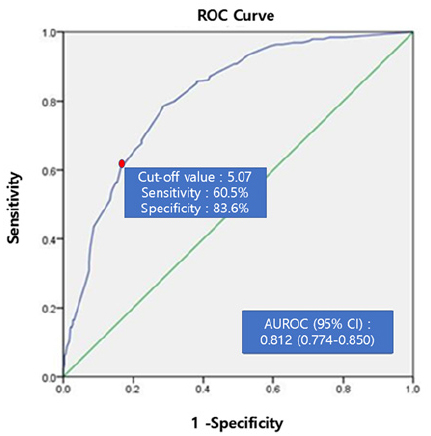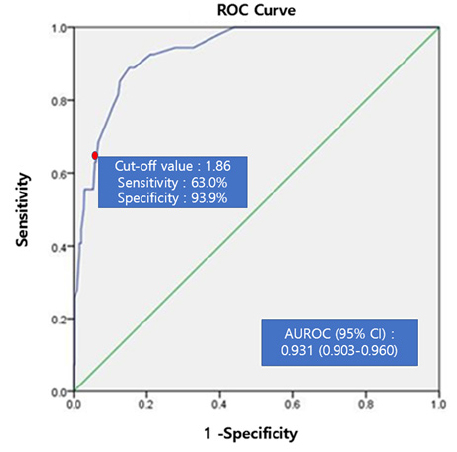Korean J Health Promot.
2017 Jun;17(2):91-98. 10.15384/kjhp.2017.17.2.91.
Diagnostic Usefulness of Korean Standard on Heavy Drinking for the DSM-5 Alcohol Use Disorder
- Affiliations
-
- 1Department of Family Medicine, Sun Healthcare International, Yuseong Sun Hospital, Daejeon, Korea.
- 2Department of Family Medicine, Research Institute for Medical Sciences, Chungnam National University School of Medicine, Daejeon, Korea. josephkim@cnu.ac.kr
- KMID: 2411434
- DOI: http://doi.org/10.15384/kjhp.2017.17.2.91
Abstract
- BACKGROUND
This research investigated the usefulness of heavy drinking standards of "˜guidelines for moderate alcohol drinking amount for Koreans' for diagnosis of Diagnostic and Statistical Manual of Mental Disorders 5th edition (DSM-5) alcohol use disorder.
METHODS
This retrospective study was conducted with 976 adults who visited an health screening center in Daejeon for health check-up in 2015. Daily drinking amount, drinking frequency per week, and weekly drinking amount were investigated. Using the heavy drinking criteria of Korean guideline, participants were grouped by age and gender and classified as normal or heavy drinkers. The sensitivity, specificity, positive predictive value (PPV), negative predictive value (NPV), Positive likelihood ratio (LR+), Negative likelihood ratio (LR-), odds ratio (OR) and Youden's Index of heavy drinking according to Korean guideline for diagnosis of DSM-5 alcohol use disorder were calculated.
RESULTS
The Area under the receiver operating characteristic (ROC) curve of a model screening DSM-5 alcohol use disorder by weekly drinking amount were 0.812 in males up to age 65 years and 0.931 in males over age 65 years and females respectively. The sensitivity, specificity, PPV and NPV of Korean guideline heavy drinking group for diagnosis of DSM-5 alcohol use disorder were 61.0%, 89.7%, 67.0%, and 87.05% respectively. The LR+, LR-, OR and Youden's Index of those were 5.917 (4.704-7.435), 0.434 (0.379-0.497), 13.623 (9.607-19.317), and 0.507 respectively.
CONCLUSIONS
This research shows the Korean heavy drinking standard is useful for diagnosis of DSM-5 alcohol use disorder in Korean people.
Keyword
MeSH Terms
Figure
Cited by 1 articles
-
Knowledge and Attitude of Health Care Providers for Korean National Health Examination
Seo Young Kang, Jung Ah Lee, Young Sik Kim
Korean J Health Promot. 2017;17(4):252-258. doi: 10.15384/kjhp.2017.17.4.252.
Reference
-
1. Beseler CL, Taylor LA, Leeman RF. An item-response theory analysis of dsm-iv alcohol-use disorder criteria and “binge” drinking in undergraduates. J Stud Alcohol Drugs. 2010; 71(3):418–423.
Article2. Robin RW, Long JC, Rasmussen JK, Albaugh B, Goldman D. Relationship of binge drinking to alcohol dependence, other psychiatric disorders, and behavioral problems in an American Indian tribe. Alcohol Clin Exp Res. 1998; 22(2):518–523.
Article3. Knight JR, Wechsler H, Kuo M, Seibring M, Weitzman ER, Schuckit MA. Alcohol abuse and dependence among U.S. college students. J Stud Alcohol. 2002; 63(3):263–270.
Article4. Kim SG, Kim JS, Pack HJ, Sung HN. Usefulness of heavy drinking and binge drinking for the diagnosis of alcohol use disorder. Korean J Fam Med. 2016; 37(4):214–220.
Article5. Cherpitel CJ. Analysis of cut points for screening instruments for alcohol problems in the emergency room. J Stud Alcohol. 1995; 56(6):695–700.
Article6. Shibuya A, Yasunami M, Yoshida A. Genotypes of alcohol dehydrogenase and aldehyde dehydrogenase loci in Japanese alcohol flushers and nonflushers. Hum Genet. 1989; 82(1):14–16.
Article7. Jung JG, Kim JS, Oh MK. The role of the flushing response in the relationship between alcohol consumption and insulin resistance. Alcohol Clin Exp Res. 2010; 34(10):1699–1704.
Article8. Jung JG, Kim JS, Yoon SJ, Oh MK. Relationships among alcohol consumption, facial flushing response, and metabolic syndrome in healthy men. Ann Epidemiol. 2012; 22(7):480–486.
Article9. Suh HS, Kim JS, Kim SS, Jung JG, Yoon SJ, Ahn JB. Influence of the flushing response in the relationship between alcohol consumption and cardiovascular disease risk. Korean J Fam Med. 2014; 35(6):295–302.
Article10. Kim EC, Kim JS, Jung JG, Kim SS, Yoon SJ, Ryu JS. Effect of alcohol consumption on risk of hyperhomocysteinemia based on alcohol-related facial flushing response. Korean J Fam Med. 2013; 34(4):250–257.
Article11. Kim SG, Kim JS, Kim SS, Jung JG, Yun SJ, Kim EC. Relationships between the level of alcohol consumption and abnormality in biomarkers according to facial flushing in Korean male drinkers. Korean J Fam Med. 2013; 34(2):123–130.
Article12. Jung JG, Kim JS, Kim YS, Oh MK, Yoon SJ. Hypertension associated with alcohol consumption based on the facial flushing reaction to drinking. Alcohol Clin Exp Res. 2014; 38(4):1020–1025.
Article13. Kim JS. Guideline of moderate alcohol drinking amount for Koreans. Korean J Fam Pract. 2015; 5:Suppl 1. S117–S119.14. National Institute of Alcohol Abuse and Alcoholism. Rethinking drinking: Alcohol and your health [Internet]. Bethesda: Natio nal Institute of Alcohol Abuse and Alcoholism;2016. Accessed June 25, 2017. Available from: https://pubs.niaaa.nih.gov/publications/RethinkingDrinking/Rethinking_Drinking.pdf.15. Bouchery EE, Harwood HJ, Sacks JJ, Simon CJ, Brewer RD. Economic costs of excessive alcohol consumption in the U.S., 2006. Am J Prev Med. 2011; 41(5):516–524.
Article16. Naimi TS, Brewer RD, Mokdad A, Denny C, Serdula MK, Marks JS. Binge drinking among US adults. JAMA. 2003; 289(1):70–75.
Article17. Willenbring ML, Massey SH, Gardner MB. Helping patients who drink too much: an evidence-based guide for primary care physicians. Am Fam Physician. 2009; 80(1):44–50.18. Muller MP, Tomlinson G, Marrie TJ, Tang P, McGeer A, Low DE, et al. Can routine laboratory tests discriminate between severe acute respiratory syndrome and other causes of community-acquired pneumonia? Clin Infect Dis. 2005; 40(8):1079–1086.
Article19. Song SW. Using the receiver operating characteristic (ROC) curve to measure sensitivity and specificity. Korean J Fam Med. 2009; 30(11):841–842.
Article20. Nam TW, Kim JS, Kim SS, Jung JG, Kang DS, Hyeon YH, et al. Utility of single alcohol questions related to binge drinking in identifying problem drinkers. Korean J Fam Med. 2009; 30(10):777–783.
Article21. McGee S. Simplifying likelihood ratios. J Gen Intern Med. 2002; 17(8):646–649.
Article22. Henderson MC, Tierney LM, Smetana GW. The patient history: an evidence based approach to differential diagnosis. 2nd ed. New York: McGrawHill;2012. p. 30.23. Anderson ML, Nokia MS, Govindaraju KP, Shors TJ. Moderate drinking? Alcohol consumption significantly decreases neurogenesis in the adult hippocampus. Neuroscience. 2012; 224(8):202–209.
Article
- Full Text Links
- Actions
-
Cited
- CITED
-
- Close
- Share
- Similar articles
-
- Usefulness of Heavy Drinking and Binge Drinking for the Diagnosis of Alcohol Use Disorder
- Usefulness of the Alcohol Use Disorders Identification Test in Screening for Problem Drinkers among College Students
- Ethnographic Study on Concept of Alcoholism in Korea(II): Focus Group Study
- Usefulness of Alcohol-screening Instruments in Detecting Problem Drinking among Elderly Male Drinkers
- Usefulness of the Alcohol Use Disorders Identification Test–Korean Revised Version in Screening for Diagnostic and Statistical Manual of Mental Disorders 5th Edition Alcohol Use Disorder among College Students



